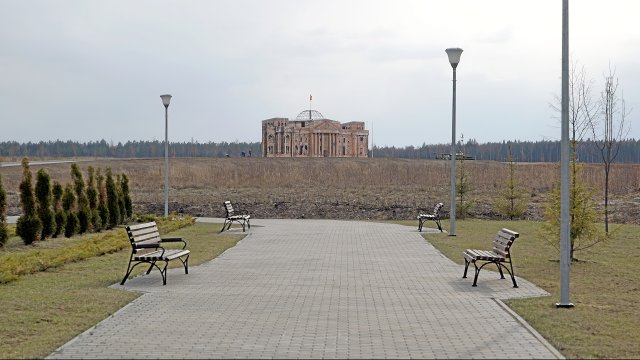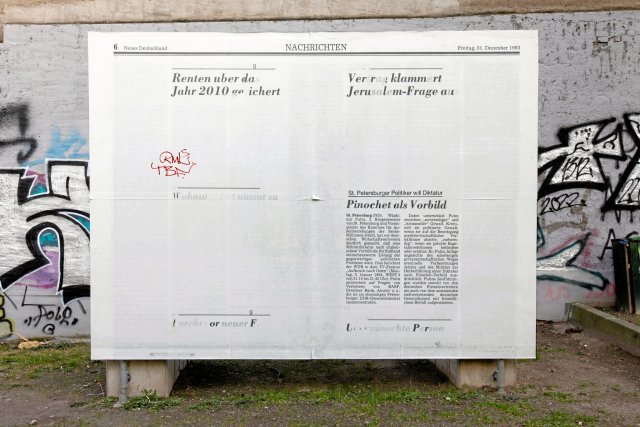View of the replica of the Reichstag in a Russian forest: film still from a video work from 2019 that is part of “Recapitulate”.
Photo: Juliane Jaschnow
This year you are taking part in the Pirna Sculpture Summer for the first time. The work you are showing is a multi-part installation centered on a very strange place: a park in Russia where the German Reichstag building has been recreated. Have you been there yourself?
I was there in 2019 and visited the Reichstag copy in the “Park Patriot”. This is a military-patriotic adventure park, about an hour’s drive from Moscow, which is aimed primarily at children, young people and families. I filmed on location for “Recapitulate,” my work that has continued to evolve since then. There is much more there, for example, there is the newly built main church of the Armed Forces of Russia, there is a partisan village, shooting halls, a site for military fairs. It is a very large area that has continued to expand in recent years.
Interview

Juliane Jaschnow
Juliane Jaschnow is an artist and filmmaker who lives and works in Leipzig. She studied fine arts in the expanded cinema and photography department at the HGB Leipzig and is a graduate of the PMMC Professional Media Master Class for artistic documentary film at the werkleitz Center for Media Art Halle (Saale). She is a member of the Leipzig FILZ film initiative.
And why is there a replica of the Reichstag there?
The main object is what remains of a fairly large re-enactment (as authentic a re-enactment of a historical event as possible, editor’s note) that took place on the park grounds in 2017. In one hour, the last days of the Battle of Berlin in the spring of 1945 were recreated in a very compressed manner using extras, tanks and scenery. The end of the war, especially the storming of the Reichstag and the hoisting of the Soviet flag on the roof of the building, plays a central role in Russian commemorative culture surrounding the Second World War. The reenactment, like the entire park, was financed by the Russian Ministry of Defense.
What interested you about this?
I have been following what is happening in Russia in terms of memory politics and culture for several years. This also has to do with a personal interest, as I come from a German-Russian family. The reenactment was approved in the Duma in 2017 by the Minister of Defense Sergei Shoigu announced with the comment “… so that our young soldiers don’t storm something, but a specific object.” When I later found out that the Reichstag copy was not dismantled after the reenactment, but is now embedded in a military park as a sight, I was interested. I started to look at the staging of history, the German-Russian culture of remembrance and the Reichstag itself, including its significance here in Germany. The Reichstag is an important monument not only for Russian but also for German collective memory – and, at least here, its significance has changed again and again over the decades.
In what way?
In 1933 the Reichstag was set on fire. It is still unclear today whether the arson was staged. The National Socialists blamed the communists and used the fire as an opportunity to suspend basic rights. The event is also symbolic of the beginning of Nazi terror. Then of course there is the photograph of the Soviet soldiers raising the flag with a hammer and sickle on the roof of the Reichstag – an iconic image for the Germans as well, which symbolizes the end of the war and the liberation from the Nazis. Incidentally, the flag-raising scene for this photo was re-enacted two days after the actual storming, on behalf of Stalin. During the division of Germany, the wall ran directly next to the Reichstag; after the fall of the Wall, the parliament moved in there again. It is a very symbolically charged building and sometimes a projection surface for various ideologies. For example, if you search for the keyword “storming the Reichstag” on the Internet today, the first images that appear are of the attempted storming of the Reichstag by so-called Reich citizens in 2020 during a Corona demonstration. Before 2020 there were only black and white photos from 1945.
Jaschnow also integrated a “nd” article from 1993 into her series of works. Subject of the report: Vladimir Putin said that he wanted a military dictatorship based on the Chilean model.
Photo: Juliane Jaschnow
Isn’t that also a re-enactment?
Yes, that is very interesting: an image from our collective memory is being reactivated here; it is an attempt to appropriate a historical event using the same imagery in order to use and appropriate its effectiveness for one’s own purposes. I am interested in how images can shape and overwrite our memories and ultimately influence the present. And how they can be exploited for propaganda purposes. One element of the work series “Recapitulate” refers to the attempted storming of the Reichstag in 2020.
You started working on these issues a few years before the Russian invasion of Ukraine in 2022. Did your relationship to “Recapitulate” change with the Ukraine war?
The video work, which was created in 2019 and forms the core of the work, itself has not changed – it is now a kind of time capsule, belonging to a past state of the world. I notice that people who look at this today now have different comments and questions than before February 2022. Our view has changed: the material is looked at differently; We are looking for clues as to what happened.
Did you know anything about it back then?
When I viewed and assembled the film material – my own material, but also a lot from the Internet, mainly from the social media channels of the Russian Ministry of Defense – I naturally asked myself what the propaganda was aimed at. Whether it’s about consolidating Putin’s power with the help of collective identity-forming memory or what people should be prepared and attuned to. Like most people, I didn’t see it coming that Ukraine would be attacked on this scale. I’m continuing to work on the topic. This year a new part of “Recapitulate” was created, in which an article from “Neues Deutschland” from 1993 also plays a role. (see photo, editor’s note)
You artistically deal with very political themes. Do you attribute a specific task to your art?
I don’t see my work as a task. There is currently a lot of discussion about where the boundaries between art and activism lie. Basically, I think that art has the potential to negotiate things differently than what happens in everyday life or politics – also with regard to ambiguity and complexity.
What do you mean by that?
As an artist, I can show that there are things that exist in parallel, that are perhaps sometimes incompatible with each other. I’m not interested in conveying a compressed message. First of all, I see art as a tool – to dissect, sort and understand something in the process. I am interested in the multi-layered nature of a condition. History is not one-dimensional either. There are always different perspectives, overlays, reactivations.
The Pirnaer Sculpture Summer, this year under the motto “Attitude. Attitudes”, runs until September 29th. Curated by Christiane Stoebe, works by German and Czech artists can be seen. Classic sculptural sculptures are also juxtaposed with multimedia installation works.
Become a member of the nd.Genossenschaft!

Since January 1, 2022, the »nd« will be published as an independent left-wing newspaper owned by the staff and readers. Be there and support media diversity and visible left-wing positions as a cooperative member. Fill out the membership form now.
More information on www.dasnd.de/genossenschaft
judi bola online sbobet sbobet88 judi bola online

